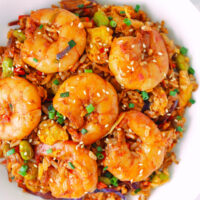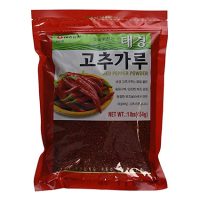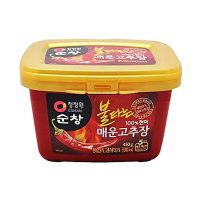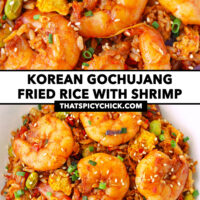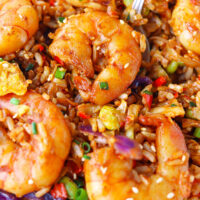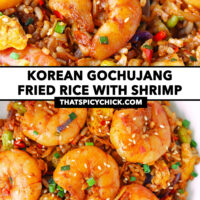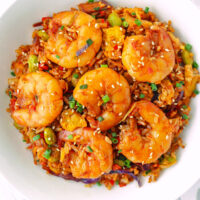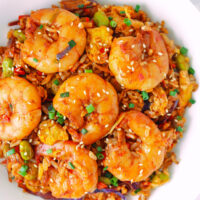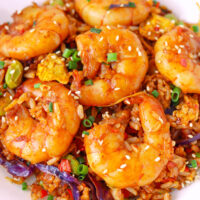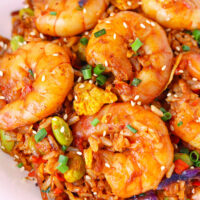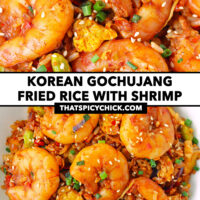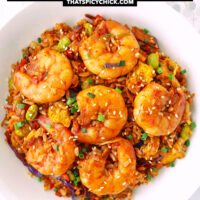 Buy Now →
Buy Now → Gochujang Fried Rice
Juicy jumbo shrimp, fragrant aromatics, veggies, and rice get tossed in a savory and spicy-sweet gochujang infused sauce in this Gochujang Fried Rice! It’s ready in under 30 minutes, customizable, and so DELICIOUS!
- Prep Time: 15
- Cook Time: 10
- Total Time: 25 minutes
- Yield: 2 1x
- Category: Dinner
- Method: Stir-fry
- Cuisine: Korean
Ingredients
Scale
For the Shrimp:
- ½ TBLS Gochujang (Korean chili pepper paste – note 1)
- 1 TSP Low Sodium Light Soy Sauce
- ⅛ TSP ground Black Pepper
- ¼ TSP Sesame Oil
- 300 grams / 10.6 ounces peeled and deveined Shrimp (or prawns – size 16/20 recommended)
- 1 TSP Peanut Oil (or any neutral oil with a high smoke point), for cooking
For the Sauce:
- 1 TBLS Low Sodium Light Soy Sauce
- 30 grams / 1 TBLS Gochujang
- 1 TSP Distilled White Vinegar
- ½ TSP granulated Sugar-Free Sweetener (I used Wholesome Zero Sugar – note 2)
- ¼ TSP Gochugaru (Korean hot pepper powder – note 3), to taste
- ½ TSP Sesame Oil
For the Fried Rice:
- 50 grams / ¼ medium Yellow Onion – finely chopped
- 20 grams / 1 medium Spring Onion (Scallion/Green Onion) – finely chopped, white and light green parts separated from the dark green parts
- 8 grams / ≈ 1 TBLS minced Ginger
- 25 grams / 4-5 Garlic cloves – minced
- 35 grams / 9-10 fresh Red Chilies (Thai Bird’s Eye or any other small hot red chilies – note 4*), to taste – finely chopped
- 1 large Egg – lightly beaten
- 100 grams / 1 heaped cup Coleslaw Salad Mix (red and green cabbage and carrots – note 5)
- 75 grams / ½ cup Frozen Shelled Edamame, thawed
- 239 grams / 1.5 cups cooked Thai Jasmine Brown Rice, day-old, chilled (100 grams / 3.5 ounces uncooked weight)
- ¼ TSP ground Kosher Salt, to taste
- ⅛ TSP ground Black Pepper, to taste
- To Serve: Toasted white or black sesame seeds, reserved chopped spring onion
Instructions
Prep:
- Marinate the shrimp: In a large bowl, mix together the gochujang, low sodium light soy sauce, ground black pepper and sesame oil until combined well. Add the shrimp and mix to coat, set aside.
- Make the sauce: Mix together the low sodium light soy sauce, gochujang, distilled white vinegar, gochugaru, granulated sugar-free sweetener and sesame oil in a measuring cup (for easier pouring) or small bowl until combined well.
- Prepare the fresh ingredients: Chop the yellow onion, spring onion (separating the white and light green parts from the dark green parts), ginger, garlic, and fresh red chilies as indicated in the ‘ingredients’ section. Crack the egg into a bowl and lightly beat.
For the Gochujang Fried Rice:
- Cook the shrimp: Heat 1 teaspoon peanut oil in a large nonstick wok or heavy bottomed deep skillet over medium-high heat. Add the shrimp and spread the pieces out in the wok. Cook for 2-3 minutes, turning the pieces over halfway, until just cooked. Transfer to a clean bowl and set aside. Scrape out and discard any burnt marinade bits if needed.
- Stir fry the aromatics: Heat the remaining ½ tablespoon of peanut oil in the wok over high heat. Add the yellow onion, spring onion white and light green parts and ginger. Stir-fry for 30 seconds until the onion starts to soften. Add the garlic and red chilies and stir-fry for 30 seconds until fragrant.
- Add the veggies: Add the tri-color coleslaw salad mix and edamame. Stir-fry for 30-40 seconds to combine.
- Cook the egg: Push everything to the side of the wok and pour in the egg. Allow to set for 20 seconds then break it up into pieces and toss to combine with everything else.
- Add the rice and sauce: Add the rice and pour the sauce on top. Stir-fry for 1 minute or until every grain of rice is evenly coated with the sauce.
- Season and add the shrimp: Season with kosher salt and ground black pepper. Add the cooked shrimp and toss for 1 minute to combine.
- Toss through spring onion: Toss through most of the spring onion dark green parts (reserve some for garnish) and switch off the heat.
- To Serve: Divide evenly onto plates or into bowls. Garnish with toasted white sesame seeds and the reserved spring onion dark green parts. Serve immediately.
Notes
- Gochujang. This is a fermented Korean chili pepper paste that comes in small tubs and is full of umami. Its color is a shade of dark red and it’s spicy-sweet and smoky in flavor, not just pure spicy. I used an extra spicy one from Chung Jung One brand, but regular spice level gochujang is great too. Find it in the Asian aisle of a well-stocked supermarket with international ingredients, Asian and Korean supermarkets or purchase it online.
- Granulated Sugar-Free Sweetener. I used Wholesome Zero Sugar which is a calorie-free and sugar-free erythritol based sweetener. Use any other sugar-free sweetener made from stevia, monk fruit, etc. you like. You can also use regular granulated white sugar, or honey or pure maple syrup if you prefer to use a natural sweetener.
- Gochugaru. This is a Korean hot pepper powder. Look for it in a Korean grocery store or purchase it online. Depending on the brand, some gochugaru powders may be quite spicy so adjust the quantity to taste. Substitute with chili powder or leave it out completely if you prefer a milder fried rice.
- Red Chilies: Use less or omit for a milder fried rice.
- Coleslaw Salad Mix: You can also use matchstick cut carrots and sliced cabbage instead of a store-bought coleslaw salad mix. I prefer the latter for convenience in this recipe.
- Meal prep option and reheating leftovers. This fried rice will keep for up to 3 days if stored properly in the fridge in airtight sealed containers. If you switch the protein to chicken, it will last for up to 4 days in the fridge. Double the recipe ingredients by clicking the ‘2x’ button at the top of the recipe card to make 4 servings. Be sure to use a large enough wok or pan for cooking so that the fried rice doesn’t become mushy. I recommend cooking in two batches if your wok is not large enough. To reheat, microwave on high for 1-2 minutes until hot throughout.
- See ‘Variations’ section in the post above if you’d like to customize this fried rice.
Nutrition
- Serving Size: ½ of recipe
- Calories: 564
- Sugar: 12.3g
- Sodium: 1622.1mg
- Fat: 15.1g
- Saturated Fat: 8.8g
- Unsaturated Fat: 7.7g
- Trans Fat: 0g
- Carbohydrates: 71.1g
- Fiber: 8.7g
- Protein: 42.4g
- Cholesterol: 93mg
Find it online: https://thatspicychick.com/gochujang-fried-rice/
